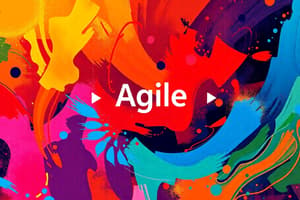Podcast
Questions and Answers
What is the purpose of a daily Scrum meeting in Scrum?
What is the purpose of a daily Scrum meeting in Scrum?
- To avoid discussing progress
- To skip work items for the day
- To criticize team members' work
- To review progress and decide the work for the day (correct)
Who is responsible for ensuring that the development team remains focused on the product being built?
Who is responsible for ensuring that the development team remains focused on the product being built?
Product Owner
The ScrumMaster in Scrum serves as a traditional project manager.
The ScrumMaster in Scrum serves as a traditional project manager.
False (B)
What is the main focus of agile software engineering?
What is the main focus of agile software engineering?
In Scrum, sprints are fixed-length periods lasting __ weeks.
In Scrum, sprints are fixed-length periods lasting __ weeks.
Agile methods prioritize working software over comprehensive documentation. Is this statement true or false?
Agile methods prioritize working software over comprehensive documentation. Is this statement true or false?
What is the purpose of incremental development in agile methods?
What is the purpose of incremental development in agile methods?
Extreme Programming is known for pushing good practices to '_____' levels.
Extreme Programming is known for pushing good practices to '_____' levels.
Match the Scrum terminology:
Match the Scrum terminology:
What is a key characteristic of a self-organizing team in Agile?
What is a key characteristic of a self-organizing team in Agile?
Scrum emphasizes the use of fixed-time activities known as sprints
Scrum emphasizes the use of fixed-time activities known as sprints
What is maintained in Scrum as a list of work items to be completed?
What is maintained in Scrum as a list of work items to be completed?
Sprints are fixed-time activities where a product increment is developed and should be 'potentially shippable' without needing further ________________ before delivery.
Sprints are fixed-time activities where a product increment is developed and should be 'potentially shippable' without needing further ________________ before delivery.
What is the purpose of sprint planning?
What is the purpose of sprint planning?
What is a sprint backlog?
What is a sprint backlog?
Scrum meetings are meant to be short and focused.
Scrum meetings are meant to be short and focused.
The ideal Scrum team size is between __ and __ people.
The ideal Scrum team size is between __ and __ people.
Match the following agile activities with their descriptions:
Match the following agile activities with their descriptions:
Flashcards are hidden until you start studying
Study Notes
Agile Software Engineering
- Agile software engineering focuses on delivering functionality quickly, responding to changing product specifications, and minimizing development overheads.
- There is no 'best' agile method or technique; it depends on who is using the technique, the development team, and the type of product being developed.
Agile Methods
- Agile methods were developed in the 1990s to address the limitations of plan-driven development, which involves significant overheads and documentation.
- Agile methods focus on the software rather than its documentation, develop software in a series of increments, and aim to reduce process bureaucracy as much as possible.
Agile Manifesto
- The Agile Manifesto values:
- Individuals and interactions over processes and tools
- Working software over comprehensive documentation
- Customer collaboration over contract negotiation
- Responding to change over following a plan
Incremental Development
- All agile methods are based on incremental development and delivery.
- Product development focuses on software features, with a feature doing something for the software user.
- Incremental development involves prioritizing features, implementing the most important features first, and delivering the system increment.
Incremental Development Activities
- Choose features to be included in an increment
- Refine feature descriptions
- Implement and test
- Integrate feature and test
- Deliver system increment
Agile Development Principles
- Involve the customer closely with the software development team.
- Embrace change and adapt the software to cope with changes as they are made.
- Develop and deliver incrementally, testing and evaluating each increment as it is developed.
- Maintain simplicity in both the software being developed and in the development process.
- Focus on people, not things, and trust the development team.
Extreme Programming (XP)
- XP is an influential agile method that focuses on rapid, incremental software development, change, and delivery.
- XP techniques include:
- Test-first development
- Continuous integration
- Refactoring
- Incremental planning/user stories
- Small releases
- Collective ownership
- Pair programming
- On-site customer
- Sustainable pace
Scrum
- Scrum is an agile method that provides a framework for agile project organization and planning.
- Scrum does not mandate any specific technical practices.
- Scrum terminology includes:
- Product
- Product owner
- Product backlog
- Development team
- Sprint
- Scrum
- ScrumMaster
- Potentially shippable product increment
- Velocity
Scrum and Sprints
- In Scrum, software is developed in sprints, which are fixed-length periods (2-4 weeks) in which software features are developed and delivered.
- Sprints should produce a 'shippable product increment'.
Product Backlogs
- The product backlog is a list of what needs to be done to complete the development of the product.
- The product backlog may include a variety of different items, such as product features, user requests, essential development activities, and desirable engineering improvements.
- The product backlog should always be prioritized.
Product Backlog Items
- Examples of product backlog items include:
- Features to be implemented
- User requests
- Development activities
- Engineering improvements
Product Backlog Item States
- Ready for consideration: high-level ideas and feature descriptions that will be considered for inclusion in the product.
- Ready for refinement: the team has agreed that this is an important item that should be implemented, but requires further refinement.
- Ready for implementation: the PBI has enough detail for the team to estimate the effort involved and to implement the item.### Agile Software Engineering
- Agile software engineering methods are geared towards rapid product development and delivery.
- Agile methods are based on iterative development and minimizing overheads during the development process.
Extreme Programming (XP)
- XP is an influential agile method that introduced agile development practices.
- Practices include:
- User stories
- Test-first development
- Continuous integration
Scrum
- Scrum is an agile method that focuses on agile planning and management.
- Unlike XP, Scrum does not define the engineering practices to be used.
- The development team may use any technical practices they believe are appropriate for the product being developed.
Product Backlog
- The product backlog is a list of work items to be completed.
- Each increment of the software implements some of the work items from the product backlog.
Sprint
- Sprints are fixed-time activities (usually 2-4 weeks) where a product increment is developed.
- Increments should be 'potentially shippable' i.e., they should not need further work before they are delivered.
Self-Organizing Team
- A self-organizing team is a development team that organizes the work to be done by discussion and agreement amongst team members.
Sprint Activities
- Sprint planning:
- Establish an agreed sprint goal
- Decide on the list of items from the product backlog to be implemented
- Create a sprint backlog
- Sprint execution:
- Work on the sprint backlog items
- Implement the product backlog items
- Sprint reviewing:
- Review the work done during the sprint
- Identify new problems and issues
- Reflect on how to improve the way they work
Scrum Meeting
- Daily Scrum (also known as Daily Stand-up):
- A short, daily meeting to coordinate the team's work
- Share information, describe progress, and plan for the day
- Review the sprint backlog
Sprint Goals
- Sprint goals may be focused on:
- Software functionality
- Support
- Performance and reliability
Agile Activities
- Test automation:
- Automate product testing as much as possible
- Develop a suite of executable tests
- Continuous integration:
- Integrate software components immediately
- Test the system to check for unanticipated component interaction problems
Code Completeness Checklist
- Reviewed:
- Code has been reviewed by another team member
- Checked for coding standards, understandability, and comments
- Unit tested:
- All unit tests have been run automatically
- All tests have executed successfully
- Integrated:
- Code has been integrated with the project codebase
- No integration errors reported
- Integration tested:
- All integration tests have been run automatically
- All tests have executed successfully
- Accepted:
- Acceptance tests have been run (if appropriate)
- Product owner or development team has confirmed the product backlog item has been completed
Team Size and Composition
- Ideal Scrum team size is between 5 and 8 people
- Teams should have diverse skills and experience
- Team members should be able to communicate informally and effectively
External Interactions
- Scrum assumes that the ScrumMaster and Product Owner should be involved in external interactions
- The team should focus on development and minimize external interference or distractions
Project Management
- In larger companies, there is a need for development teams to report on progress to company management
- The ScrumMaster may have to take on project management responsibilities
- Project management responsibilities include:
- Reporting
- Budgeting
- Scheduling
- Risk management
- Progress tracking
Studying That Suits You
Use AI to generate personalized quizzes and flashcards to suit your learning preferences.




